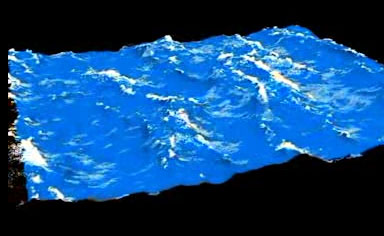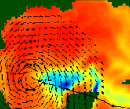At the center of Dr. Isaac Ginis's research is the air-sea interface and how it affects hurricanes. The understanding
of the physics of the atmosphere and the ocean and how they interact is translated into a set of mathematical
formulas that are then used to simulate hurricanes and make forecasts.
"There are so many different physical processes involved with this large span of scales. It's a multi-scale problem that makes a lot of people busy and excited." |
"Understanding the air-sea interface is one of the most critical pieces that remain to be solved in order to make
a breakthrough in intensity predictions," says Isaac. The area near the water's surface is a wild environment, with
huge waves breaking, forming sea spray and affecting wind and currents. It's a complicated interaction, and Isaac
is working to find ways to simulate this environment numerically in a computer model.
Isaac was one of the first scientists to argue that the interaction between atmospheric conditions and the ocean is
important for predicting hurricane movements. "Twenty years ago this was novel idea," says Isaac. Most meteorologists
focus on atmosphere, but hurricanes draw their energy from the ocean, converting sea surface evaporation into the
heat that ultimately drives winds.
The air-sea interface is a currently funded research topic for Isaac, on which several of his grad students are
working. They are looking at seaspray, a component in high wind conditions, and on predicting waves. It is a
challenge to be trying to look closely at conditions for which it is extremely difficult to take measurements. To
date this has meant flying a plane low into hurricane conditions, though there is some potential for allowing
unmanned military drones to collect data. "If you cannot measure what's going on then you don't have a reference
point," says Isaac. "We could give up until we can make measurements, but we have some good ideas. Our approach is
theoretical, using measurements done in laboratories by simulating strong wind conditions."
Simulated winds are created in big tanks, using fans to generate waves and seaspray, then the measurements are
extrapolated into the hurricane conditions. Isaac is looking at seaspray to discover, among other things, how the
size of tiny droplets affects huge hurricane systems. "There are so many different physical processes involved with
this large span of scales, both spatial and time scales," says Isaac. "It's a fascinating interaction between
different time and spatial scales, a multi-scale problem that makes a lot of people busy and excited."



